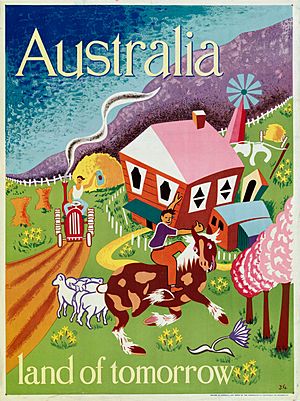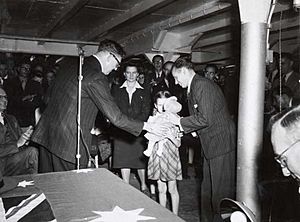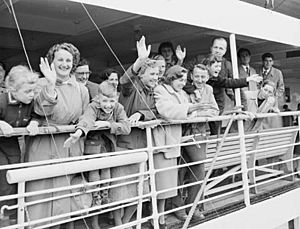Post-war immigration to Australia facts for kids
After World War II, Australia welcomed many new people. This period, from 1945 until 1973, saw a large number of immigrants, mostly from Europe. This big move of people changed Australia a lot.
Right after the war, Australia's Prime Minister, Ben Chifley, created a special government department. This department was in charge of a huge plan to bring more people to Australia. A report said Australia needed more people for defence and to grow as a country. It suggested increasing the population by 1% each year through immigration.
The first Minister for Immigration, Arthur Calwell, used a famous saying: "populate or perish." This meant Australia needed more people to survive and thrive. He also called new arrivals "New Australians" to help them feel welcome.
About 4.2 million immigrants came to Australia between 1945 and 1985. Around 40% of them came from Britain and Ireland. Many others were refugees from Europe after the war. More than 182,000 people were helped by the International Refugee Organisation (IRO) to move to Australia by 1954. This was even more than the number of convicts sent to Australia in its early history.
Contents
Why Australia Needed More People
The "Populate or Perish" Idea
During World War II, Australia was attacked in Darwin. This made the government worried about future attacks. They realised Australia needed a bigger population to defend itself and to develop the country.
So, in 1945, the government started the new immigration program. They wanted to increase the population by 1% each year. This goal was summed up by the slogan "populate or perish."
Helping People Move to Australia
The government first wanted most new arrivals to be from Great Britain. They even started a plan in 1945 to help British people pay for their journey to Australia. This was called the Assisted Passage Migration Scheme.
However, after the war, Britain did not have enough ships. So, Australia had to look for people from other places. They started welcoming refugees from Eastern Europe. Many of these people were escaping the Red Army and were happy to start a new life in Australia. The US helped by providing ships for these journeys.
Changes Over Time

The goal of increasing the population by 1% each year continued even when the government changed in 1949. The new Prime Minister, Robert Menzies, continued the immigration program.
At first, most immigrants were British. But from 1953 to 1956, more people came from Southern Europe. This made the Australian government a bit worried. They then started a campaign called "Bring out a Briton" to encourage more British people to come.
Hundreds of thousands of people from Europe moved to Australia. Over 1,000,000 British people came with financial help. To qualify, people needed to be healthy and under 45 years old.
Many new arrivals found jobs easily. Australia's economy was strong, unlike war-torn Europe. Migrants worked in factories and on big government projects.
The Snowy Mountains Scheme
One famous project was the Snowy Mountains Scheme. This huge project built dams and power stations in south-east Australia. It lasted from 1949 to 1974. It was the biggest engineering project ever in Australia. About 100,000 people from over 30 countries worked on it. Many people see this project as the start of Australia becoming a multicultural country.
By 1955, Australia welcomed its one-millionth post-war immigrant. Australia's population grew from 7 million in 1945 to 10 million in 1959.
End of the White Australia Policy
For many years, Australia had a policy called the White Australia policy. This policy made it hard for non-European people to immigrate. But in 1973, the government changed this. They made immigration fair for everyone, no matter where they came from.
This change marked the end of the main wave of European immigration. It also started a new period where more people from Asia began to move to Australia. This new wave of immigration continues today.
How Australia Helped Newcomers
Australia made agreements with different countries and international groups to help people move.
- United Kingdom: British immigrants often got free or very cheap tickets. They were known as Ten Pound Poms.
- Ex-servicemen: Soldiers who fought in the war from the British Empire and the United States also received help. This was later extended to ex-soldiers and resistance fighters from other Allied countries.
- Refugees: Australia worked with the International Refugee Organization (IRO). They agreed to take at least 12,000 displaced people each year from camps in Europe. Australia took a lot of these refugees in the late 1940s and early 1950s.
- Other Countries: Australia also had formal agreements with countries like Malta, the Netherlands, Italy, West Germany, Turkey, and Yugoslavia. There were also informal agreements with countries like Austria, Greece, Spain, and Belgium.
Important Dates in Post-War Immigration
| Period | Events |
|---|---|
| 1947 | Australia's first place for new migrants, called a reception centre, opened at Bonegilla, Victoria. |
| 1948 | Australia signed peace treaties with countries like Italy. This meant people from these countries could come to Australia. |
| 1949 | The number of assisted migrants reached over 118,800. This was four times more than in 1948.
In August, Australia welcomed its 50,000th "New Australian." This was a child from Riga, Latvia. Work started on the Snowy Mountains Scheme. This project hired 100,000 people from at least 30 different countries. |
| 1950 | The number of people moving to Australia was very high, with 153,685 new arrivals. |
| 1951 | The first assisted migrants arrived at the Bonegilla Migrant Reception and Training Centre. By this time, the government had three main centres for non-English speaking people. |
| 1952 | The International Refugee Organization (IRO) stopped its work. After this, most refugees came to Australia with help from the Intergovernmental Committee for European Migration (ICEM). |
| 1954 | The 50,000th Dutch migrant arrived in Australia. |
| 1955 | Australia welcomed its one-millionth post-war immigrant. She was a 21-year-old from the United Kingdom. |
| 1971 | The migrant camp at Bonegilla, Victoria closed. About 300,000 migrants had stayed there over the years. |
Where New Settlers Came From
This table shows the top 10 countries where settlers came from during different periods after the war:
| Birthplace | July 1949 – June 1959 | July 1959 – June 1970 | July 1970 – June 1980 |
|---|---|---|---|
| United Kingdom & Ireland | 419,946 (33.5%) | 654,640 (45.3%) | 342,373 (35.8%) |
| Italy | 201,428 (16.1%) | 150,669 (10.4%) | 28,800 (3.0%) |
| New Zealand | 29,649 (2.4%) | 30,341 (2.1%) | 58,163 (6.1%) |
| Germany | 162,756 (13.0%) | 50,452 (3.5%) | not in top 10 |
| Greece | 55,326 (4.4%) | 124,324 (8.6%) | 30,907 (3.2%) |
| Yugoslavia | not in top 10 | 94,555 (6.5%) | 61,283 (6.4%) |
| Netherlands | 100,970 (8.1%) | 36,533 (2.5%) | not in top 10 |
| Malta | 38,113 (3.0%) | 28,916 (2.0%) | not in top 10 |
| US | 16,982 (1.4%) | 20,467 (1.4%) | 27,769 (2.9%) |
| Spain | not in top 10 | 17,611 (1.2%) | not in top 10 |
| Total settler arrivals | 1,253,083 | 1,445,356 | 956,769 |
Images for kids








